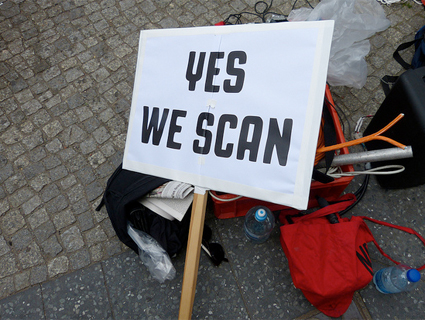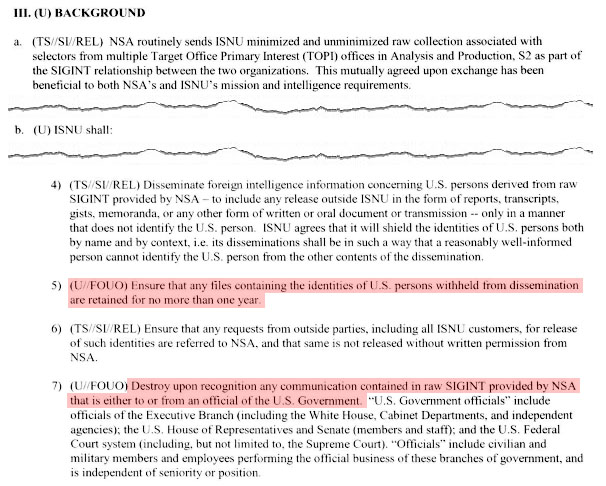
<a href="http://www.flickr.com/photos/cyzen/9080209494/sizes/z/in/photolist-eQorW7-eQc5FV-eQoqaU-eJ8Mi6-eFKHz8-eNpxAy-fidDyf-eQbW5M-eQoDMs-eQc994-eQcjHx-eQchxV-eQc8Ci-eQcuuv-eQogAo-eQbUcH-eQcpbK-eQozym-eQcqUF-eQcsEK-eQoLAb-eQoBHb-bPbQ1X-fMhdNU-fiei7u-fopczZ-fWsLSJ-f6b1He-fLyQA8-ePjKm5-6gzApM-6gDKGy-6gDLkS-dVTkhn-eFxmfZ-eFDsMY-eFxmqv-eFxmnB-fhYTYM-fDBkxo-eHSwQ6-f11a9G-fhYpu4-fhCSYt-fhThyQ-fhCU4i-fidKAj-fhTnCC-fidLWu-c1UTf-eNnJkt/">ubiquit23</a>/Flickr
This story first appeared on the TomDispatch website.
Big Bro is watching you. Inside your mobile phone and hidden behind your web browser are little known software products marketed by contractors to the government that can follow you around anywhere. No longer the wide-eyed fantasies of conspiracy theorists, these technologies are routinely installed in all of our data devices by companies that sell them to Washington for a profit.
That’s not how they’re marketing them to us, of course. No, the message is much more seductive: Data, Silicon Valley is fond of saying, is the new oil. And the Valley’s message is clear enough: we can turn your digital information into fuel for pleasure and profits—if you just give us access to your location, your correspondence, your history, and the entertainment that you like.
![]() Ever played Farmville? Checked into Foursquare? Listened to music on Pandora? These new social apps come with an obvious price tag: the annoying advertisements that we believe to be the fee we have to pay for our pleasure. But there’s a second, more hidden price tag—the reams of data about ourselves that we give away. Just like raw petroleum, it can be refined into many things—the high-octane jet fuel for our social media and the asphalt and tar of our past that we would rather hide or forget.
Ever played Farmville? Checked into Foursquare? Listened to music on Pandora? These new social apps come with an obvious price tag: the annoying advertisements that we believe to be the fee we have to pay for our pleasure. But there’s a second, more hidden price tag—the reams of data about ourselves that we give away. Just like raw petroleum, it can be refined into many things—the high-octane jet fuel for our social media and the asphalt and tar of our past that we would rather hide or forget.
We willingly hand over all of this information to the big data companies and in return they facilitate our communications and provide us with diversions. Take Google, which offers free email, data storage, and phone calls to many of us, or Verizon, which charges for smartphones and home phones. We can withdraw from them anytime, just as we believe that we can delete our day-to-day social activities from Facebook or Twitter.
But there is a second kind of data company of which most people are unaware: high-tech outfits that simply help themselves to our information in order to allow US government agencies to dig into our past and present. Some of this is legal, since most of us have signed away the rights to our own information on digital forms that few ever bother to read, but much of it is, to put the matter politely, questionable.
This second category is made up of professional surveillance companies. They generally work for or sell their products to the government—in other words, they are paid with our tax dollars—but we have no control over them. Harris Corporation provides technology to the FBI to track, via our mobile phones, where we go; Glimmerglass builds tools that the US intelligence community can use to intercept our overseas calls; and companies like James Bimen Associates design software to hack into our computers.
There is also a third category: data brokers like Arkansas-based Acxiom. These companies monitor our Google searches and sell the information to advertisers. They make it possible for Target to offer baby clothes to pregnant teenagers, but also can keep track of your reading habits and the questions you pose to Google on just about anything from pornography to terrorism, presumably to sell you Viagra and assault rifles.
Locating You
Edward Snowden has done the world a great service by telling us what the National Security Agency does and how it has sweet-talked, threatened, and bullied the first category of companies into handing over our data. As a result, perhaps you’ve considered switching providers from AT&T to T-Mobile or Dropbox to the more secure SpiderOak. After all, who wants some anonymous government bureaucrat listening in on or monitoring your online and phone life?
Missing from this debate, however, have been the companies that get contracts to break into our homes in broad daylight and steal all our information on the taxpayer’s dime. We’re talking about a multi-billion dollar industry whose tools are also available for those companies to sell to others or even use themselves for profit or vicarious pleasure.
So just what do these companies do and who are they?
The simplest form of surveillance technology is an IMSI catcher. (IMSI stands for International Mobile Subscriber Identity, which is unique to every mobile phone.) These highly portable devices pose as mini-mobile phone towers and can capture all the mobile-phone signals in an area. In this way, they can effectively identify and locate all phone users in a particular place. Some are small enough to fit into a briefcase, others are no larger than a mobile phone. Once deployed, the IMSI catcher tricks phones into wirelessly sending it data.
 By setting up several IMSI catchers in an area and measuring the speed of the responses or “pings” from a phone, an analyst can follow the movement of anyone with a mobile phone even when they are not in use.
By setting up several IMSI catchers in an area and measuring the speed of the responses or “pings” from a phone, an analyst can follow the movement of anyone with a mobile phone even when they are not in use.
One of the key players in this field is the Melbourne, Florida-based Harris Corporation, which has been awarded almost $7 million in public contracts by the Federal Bureau of Investigation (FBI) since 2001, mostly for radio communication equipment. For years, the company has also designed software for the agency’s National Crime Information Center to track missing persons, fugitives, criminals, and stolen property.
Harris was recently revealed to have designed an IMSI catcher for the FBI that the company named “Stingray.” Court testimony by FBI agents has confirmed the existence of the devices dating back to at least 2002. Other companies like James Bimen Associates of Virginia have allegedly designed custom software to help the FBI hack into people’s computers, according to research by Chris Soghoian of the American Civil Liberties Union (ACLU).
The FBI has not denied this. The Bureau “hires people who have hacking skill, and they purchase tools that are capable of doing these things,” a former official in the FBI’s cyber division told the Wall Street Journal recently. “When you do, it’s because you don’t have any other choice.”
The technologies these kinds of companies exploit often rely on software vulnerabilities. Hacking software can be installed from a USB drive, or delivered remotely by disguising it as an email attachment or software update. Once in place, an analyst can rifle through a target’s files, log every keystroke, and take pictures of the screen every second. For example, SS8 of Milpitas, California, sells software called Intellego that claims to allow government agencies to “see what [the targets] see, in real time” including “draft-only emails, attached files, pictures, and videos.” Such technology can also remotely turn on phone and computer microphones, as well as computer or cellphone cameras to spy on the target in real-time.
Charting You
What the FBI does, however intrusive, is small potatoes compared to what the National Security Agency dreams of doing: getting and storing the data traffic not just of an entire nation, but of an entire planet. This became a tangible reality some two decades ago as the telecommunications industry began mass adoption of fiber-optic technology. This means that data is no longer transmitted as electrical signals along wires that were prone to interference and static, but as light beams.
Enter companies like Glimmerglass, yet another northern California outfit. In September 2002, Glimmerglass started to sell a newly patented product consisting of 210 tiny gold-coated mirrors mounted on microscopic hinges etched on to a single wafer of silicon. It can help transmit data as beams of light across the undersea fiber optic cables that carry an estimated 90% of trans-border telecommunications data. The advantage of this technology is that it is dirt cheap and—for the purposes of the intelligence agencies—the light beams can easily be copied with almost no noticeable loss in quality.
“With Glimmerglass Intelligent Optical Systems (IOS), any signal travelling over fiber can be redirected in milliseconds, without adversely affecting customer traffic,” says the company on its public website.
Glimmerglass does not deny that its equipment can be used by intelligence agencies to capture global Internet traffic. In fact, it assumes that this is probably happening. “We believe that our 3D MEMS technology—as used by governments and various agencies—is involved in the collection of intelligence from sensors, satellites, and undersea fiber systems,” Keith May, Glimmerglass’s director of business development, told the trade magazine Aviation Week in 2010. “We are deployed in several countries that are using it for lawful interception.”
In a confidential brochure, Glimmerglass has a series of graphics that, it claims, show just what its software is capable of. One displays a visual grid of the Facebook messages of a presumably fictional “John Smith.” His profile is linked to a number of other individuals (identified with images, user names, and IDs) via arrows indicating how often he connected to each of them. A second graphic shows a grid of phone calls made by a single individual that allows an operator to select and listen to audio of any of his specific conversations. Yet others display Glimmerglass software being used to monitor webmail and instant message chats.
“The challenge of managing information has become the challenge of managing the light,” says an announcer in a company video on their public website. “With Glimmerglass, customers have full control of massive flows of intelligence from the moment they access them.” This description mirrors technology described in documents provided by Edward Snowden to the Guardian newspaper.
Predicting You
Listening to phone calls, recording locations, and breaking into computers are just one part of the tool kit that the data-mining companies offer to US (and other) intelligence agencies. Think of them as the data equivalents of oil and natural gas drilling companies that are ready to extract the underground riches that have been stashed over the years in strongboxes in our basements.
What government agencies really want, however, is not just the ability to mine, but to refine those riches into the data equivalent of high-octane fuel for their investigations in very much the way we organize our own data to conduct meaningful relationships, find restaurants, or discover new music on our phones and computers.
These technologies—variously called social network analysis or semantic analysis tools—are now being packaged by the surveillance industry as ways to expose potential threats that could come from surging online communities of protesters or anti-government activists. Take Raytheon, a major US military manufacturer, which makes Sidewinder air-to-air missiles, Maverick air-to-ground missiles, Patriot surface-to-air missiles, and Tomahawk submarine-launched cruise missiles. Their latest product is a software package eerily named “Riot” that claims to be able to predict where individuals are likely to go next using technology that mines data from social networks like Facebook, Foursquare, and Twitter.
Raytheon’s Rapid Information Overlay Technology software—yes, that’s how they got the acronym Riot—extracts location data from photos and comments posted online by individuals and analyzes this information. The result is a variety of spider diagrams that purportedly will show where that individual is most likely to go next, what she likes to do, and whom she communicates with or is most likely to communicate with in the near future.
A 2010 video demonstration of the software was recently published online by the Guardian. In it, Brian Urch of Raytheon shows how Riot can be used to track “Nick”—a company employee—in order to predict the best time and place to steal his computer or put spy software on it. “Six a.m. appears to be the most frequently visited time at the gym,” says Urch. “So if you ever did want to try to get a hold of Nick—or maybe get a hold of his laptop—you might want to visit the gym at 6:00 a.m. on Monday.”
“Riot is a big data analytics system design we are working on with industry, national labs, and commercial partners to help turn massive amounts of data into useable information to help meet our nation’s rapidly changing security needs,” Jared Adams, a spokesman for Raytheon’s intelligence and information systems department, told the Guardian. The company denies that anyone has yet bought Riot, but US government agencies certainly appear more than eager to purchase such tools.
For example, in January 2012 the FBI posted a request for an app that would allow it to “provide an automated search and scrape capability of social networks including Facebook and Twitter and [i]mmediately translate foreign language tweets into English.” In January 2013, the US Transportation Security Administration asked contractors to propose apps “to generate an assessment of the risk to the aviation transportation system that may be posed by a specific individual” using “specific sources of current, accurate, and complete non-governmental data.”
Privacy activists say that the Riot package is troubling indeed. “This sort of software allows the government to surveil everyone,” Ginger McCall, the director of the Electronic Privacy Information Center’s Open Government program, told NBC News. “It scoops up a bunch of information about totally innocent people. There seems to be no legitimate reason to get this.”
Refining fuel from underground deposits has allowed us to travel vast distances by buses, trains, cars, and planes for pleasure and profit but at an unintentional cost: the gradual warming of our planet. Likewise, the refining of our data into social apps for pleasure, profit, and government surveillance is also coming at a cost: the gradual erosion of our privacy and ultimately our freedom of speech.
Ever tried yelling back at a security camera? You know that it is on. You know someone is watching the footage, but it doesn’t respond to complaint, threats, or insults. Instead, it just watches you in a forbidding manner. Today, the surveillance state is so deeply enmeshed in our data devices that we don’t even scream back because technology companies have convinced us that we need to be connected to them to be happy.
With a lot of help from the surveillance industry, Big Bro has already won the fight to watch all of us all the time—unless we decide to do something about it.
Pratap Chatterjee, a TomDispatch regular, is executive director of CorpWatch and a board member of Amnesty International USA. He is the author of Halliburton’s Army (Nation Books) and Iraq, Inc. (Seven Stories Press).
Follow TomDispatch on Twitter and join us on Facebook or Tumblr. Check out the newest Dispatch book, Nick Turse’s The Changing Face of Empire: Special Ops, Drones, Proxy Fighters, Secret Bases, and Cyberwarfare. To stay on top of important articles like these, sign up to receive the latest updates from TomDispatch.com here.











